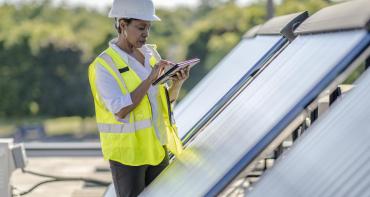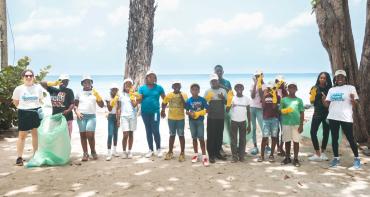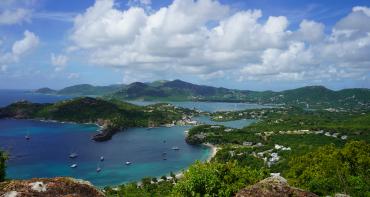The Commonwealth Blue Charter is highlighting case studies from the Commonwealth and beyond, as part of a series to spotlight best practice successes and experiences.

Share your own case study with us
“Seychelles’ Blue Economy experiences and successes to date have shown how crucial partnerships can be, especially raising innovative finance and investment. The world’s first Debt Swap for Ocean Conservation and Climate Adaptation and first sovereign Blue Bonds attest this.” Seychelles President Danny Faure, November 2018
Summary
Seychelles’ current and future prosperity is intrinsically linked to its marine and coastal assets. However, the 2008 financial crisis left the country with substantial debts and made it difficult to invest in the Blue Economy. An innovative approach to financing was required to gain the most value from Seychelles’ marine and coastal assets as part of a sustainable Blue Economy.
Seychelles pursued an ambitious plan to finance sustainable development of the Blue Economy, through converting US$21.6 million of national debt via the world’s first Blue Economy debt for nature swap, and through launching the world’s first sovereign blue bond. Seychelles’ Conservation and Climate Adaptation Trust (SeyCCAT) was established to competitively distribute funds from these initiatives to support the management and expansion of the Seychelles Marine Protected Areas (MPAs), sustainable fisheries and other activities that contribute to the conservation, protection and maintenance of biodiversity and adaptation to climate change.
These ongoing initiatives have been very successful. With the support of The Nature Conservancy, the debt conversion enabled the Government of Seychelles to make a policy commitment to safeguard 30 per cent of its Exclusive Economic Zone through MPAs. The Blue Bond raised US$15 million from international investors, demonstrating the potential for countries to harness capital markets for financing the sustainable use of marine resources. The Seychelles Blue Economy Strategic Policy Framework and Roadmap was key to the success of the Blue Bonds Plan, providing a clear plan on how the funds would be invested prior to the bonds being issued. Three rounds of the SeyCCAT Blue Grants Fund have already occurred, with the fourth due to open on 6 July 2020. Five SeyCCAT projects have been completed successfully and there are more than 20 on-going SeyCCAT partnerships and projects.
The issue
- Seychelles has an Exclusive Economic Zone (EEZ) of 1.37 million km2 (compared with a land area of just 455 km2 ). As a result, Seychelles’ current and future prosperity is intrinsically linked to its marine and coastal assets.
- The effect of the 2008 global financial crisis was hard felt in Seychelles, with the government facing repayment challenges with total public debt reaching more than 150 per cent of gross domestic product. This debt was restructured under the Paris Club and Seychelles initiated a five-year economic reform programme.
- The Seychelles Blue Economy Strategic Policy Framework and Roadmap: Charting the Future (2018–2030) was developed to guide development of the Seychelles Blue Economy and was approved in January 2018. The Strategic Policy Framework and Roadmap provides an integrated approach to ocean-based sustainable development bringing together economy, environment and society.
- One of the four pillars of the Strategic Policy Framework and Roadmap is “Economic diversification and resilience”, which links to one of the sought-after outcomes: increased investment in diversification of existing ocean-based economic sectors to realise greater value and efficiency.
- The need for greater investment in the Seychelles Blue Economy to achieve the goals and desired outcomes of the Strategic Policy Framework and Roadmap required an innovative approach to Blue Economy financing.
The response
Blue Bonds Plan
- In 2018, Seychelles launched the world’s first sovereign blue bond, designed to support sustainable marine fisheries and fisheries projects.
- Proceeds from the bond will support the expansion of Marine Protected Areas (MPAs), improved governance of priority fisheries and development of the Seychelles Blue Economy.
- Grants and loans will be provided through the Blue Grants Fund and the Blue Investment Fund, managed respectively by Seychelles’ Conservation and Climate Adaptation Trust (SeyCCAT) and the Development Bank of Seychelles (DBS).
Debt for nature swap
- The Government of Seychelles sought to undertake the world’s first Blue Economy debt for nature swap, with the aim of converting US$21.6 million of national debt
- Multiple benefits from the debt for nature swap were envisaged, including: Financing for adaptation to climate change through management of coasts, coral reefs and mangroves; Promoting implementation of a Marine Spatial Plan (MSP) for the entire Seychelles EEZ; Approximately 400,000 km2 managed for conservation as MPAs within five years; Implementing the MSP, setting ground rules for what is permitted and where within Seychelles;
- The project structure included four major milestones; financial negotiations with creditors; national stakeholder consolations; creation of an MSP; and executing the Conservation Actions.
The Seychelles’ Conservation and Climate Adaptation Trust:
- SeyCCAT was established in November 2015 to achieve conservation through innovative finance and creative collaborations.
- SeyCCAT provides sustainable funds to support the management and expansion of the Seychelles MPAs, sustainable fisheries and other activities that contribute to the conservation, protection and maintenance of biodiversity and adaptation to climate change.
- Proceeds from the Seychelles Blue Bond further capitalise the SeyCCAT Blue Grants Fund to support sustainable-use MPAs and improved governance of priority fisheries.
- SeyCCAT’s assets are projected to enable the competitive distribution of US$700,000 per year, and the Trust is investigating the feasibility of a Blue Challenge Fund and a Blue Equity Fund.
- SeyCCAT is committed to developing strong and lasting creative collaborations to advance its mission and to enable the delivery of five objectives to: Support new and existing MPAs and sustainable use zones; Empower fisheries with robust science to improve governance, sustainability, value and market options; Promote the rehabilitation of habitats and ecosystems that have been degraded by human impacts; Develop and implement risk reduction and social resilience plans to support climate change adaptation; Develop business models to secure the sustainable development of Seychelles’ Blue Economy.
For more information about SeyCCAT, see https:// seyccat.org/
Partnerships and support
Blue Bonds Plan
- The Seychelles Blue Bond was announced in 2018.
- The business case for a sovereign blue bond was identified through support from the Prince of Wales’ Charities International Sustainability Unit.
- Standard Chartered acted as placement agent for the bond and Latham & Watkins LLP advised the World Bank as external counsel. Clifford Chance LLP acted as transaction counsel.
- A World Bank team comprising experts from its Treasury, Legal, Environmental and Finance groups worked with investors, structured the blue bond and assisted the government in setting up a platform for channelling its proceeds.
- The Bond is partially guaranteed by a US$5 million guarantee from the World Bank (International Bank for Reconstruction and Development) and further supported by a US$5 million concessional loan from the Global Environment Facility (GEF), which will partially cover interest payments for the bond.
- The three international investors in the bond were Calvert Impact Capital, Nuveen and U.S. Headquartered Prudential Financial Inc.
- SeyCCAT is tasked with managing US$3 million of the US$15 million of the blue bond proceeds. DBS is managing US$12 million
Debt for nature swap
- The debt for nature swap was made possible by private funders, including the China Global Conservation Fund of The Nature Conservancy, the Jeremy and Hannelore Grantham Environmental Trust, the Leonardo DiCaprio Foundation, the Lyda Hill Foundation, the Oak Foundation, Oceans 5, the Turnbull Burnstein Family Charitable Fund and the Waitt Foundation. • Collaborators on the initiative include the governments of Belgium, France, Italy, South Africa and the UK, the United Nations Development Programme (UNDP), GEF and the Global Island Partnership. • The policy commitment to safeguard 30 per cent of the Seychelles EEZ through MPAs was financed partially through debt conversion with the support of The Nature Conservancy.
- The debt for nature swap project was a multi-step process, starting with policy commitments in 2012 and ending with SeyCCAT investing in local projects to enhance Blue Economy development in 2017.
The Seychelles’ Conservation and Climate Adaptation Trust
- SeyCCAT was established through the Conservation and Climate Adaptation Trust of Seychelles Act, 2015. SeyCCAT is a long-term, on-going initiative.
- SeyCCAT was initially capitalised with proceeds from the Government of Seychelles’ US$21.6 million debt conversion that was completed in 2015.
- SeyCCAT also attracts capital from philanthropic organisations and continues to seek other innovative mechanisms to boost its assets.
- Current partners with SeyCCAT include Pew Charitable Trusts, The Nature Conservancy, the World Bank, UNDP, the Government of Seychelles, the Western Indian Ocean Marine Science Association and local partners.
Results, accomplishments and outcomes
Blue Bonds Plan
- The bond raised US$15 million from international investors, demonstrating the potential for countries to harness capital markets for financing the sustainable use of marine resources.
- US$3 million of the proceeds from the bond are managed through SeyCCAT to support the management and expansion of Seychelles MPAs, sustainable fisheries and other activities that contribute to the conservation, protection and maintenance of biodiversity and adaptation to climate change.
- Proceeds from the bond contribute to the World Bank’s South West Indian Ocean Fisheries Governance and Shared Growth Program, supporting countries in the region to sustainably manage their fisheries and increase economic benefits from fisheries.
- The Blue Bond proceeds are issued to SeyCCAT through six tranches of US$500,000 from 2018 to 2023.
Debt for nature swap
- The journey towards the successful debt for nature swap started in 2012, when Seychelles committed to 30 per cent marine protection at Rio+20; 2013: the proposed debt restructure was discussed between the Seychelles President and the Prince of Wales; 2014: the delegation for Seychelles met main bank bilateral creditors and discussed plans to swap a portion of its external debt for funding for coastal/marine conservation projects; 2105: the Seychelles Government held discussions with key local stakeholders about MSP, and with Paris club creditors, announced the closing of the first-ever debt restricting for climate adaptation; 2016: the Government of Seychelles paid creditors to buy back their debt via a loan from SeyCCAT, funded by grants and a loan from The Nature Conservancy; 2018: SeyCCAT invested in local schemes to protect the offshore environment around the Seychelles archipelago.
- With support from The Nature Conservancy, the debt conversion enabled the Government of Seychelles to make a policy commitment to safeguard 30 per cent of its EEZ through MPAs.
- The debt service payments from the debt for nature swap fund three distinct cash flows: Repayment of the impact investor NatureVest; The SeyCCAT Blue Grants Fund, which amounts to an annually distributed US$200,000; Capitalising the SeyCCAT endowment fund with US$151,000 per year, with an expected matured value of US$6.7 million. In total, from the proceeds of the debt swap and the blue bond, SeyCCAT can annually distribute US$700,000.
The Seychelles’ Conservation and Climate Adaptation Trust
- Three rounds of the Blue Grants Fund have already occurred, with the fourth opened on 6 July 2020.
- Five SeyCCAT projects have already been successfully completed, on topics such as knowledge and impacts of artisanal fisheries, a fish identification initiative, restoration of commercially important lobster habitat and developing Blue Economy entrepreneurs.
- There are more than 20 on-going SeyCCAT partnerships and projects. These span a diverse array of topics, including science and management in fisheries, blue carbon, business development, scholarship and internships, science to support coral conservation, mangrove mapping and monitoring, climate change social adaptation, MPA development, plastic pollution and seabird and shark conservation. See https://seyccat.org/projects/
- Whilst SeyCCAT exists to develop the Seychelles Blue Economy, the Trust is also committed to sharing learning experiences with other island and coastal states across the Western Indian Ocean.
Challenges
Accessibility and inclusivity: Making funds available does not guarantee that people or organisations have the capacity to apply for those funds. The Blue Grants Fund is supported by international donors and organisations, who may not always appreciate the local challenges in applying for those funds. For example, the application form was based on a standard EU format that experienced non-governmental organisations may be able to use but local Seychelles stakeholders may not. Steps taken by SeyCCAT to make the application process more accessible and inclusive include:
- Removing language barriers: In 2019, SeyCCAT translated the application form into Creole (the local language) enabling people to apply in their native language.
- Reaching out proactively: As well as the threeislands public meeting to attract potential applicants, SeyCCAT also conducted one-to-one meetings and in-person visits with fishing communities, students, young female entrepreneurs, public sector representatives and other groups.
- Building capacity during the application stages: SeyCCAT and its partners have provided capacitybuilding sessions for the first application stage covering project and budget writing skills, project management, and monitoring and evaluation. The Project Preparation Grant also provides support at the second stage of application, and dedicated facilitators are available to support applicants through mentoring and training. For more information on fostering inclusion and accessibility, see https://seyccat.org/making-inclusionand-accessibility-a-reality/
Administrative concerns: Administering the Blue Grants Fund requires the dedication and enthusiasm of a fulltime team, with appropriate experience and training. The administration team also requires sustainable, long-term funding support. Monitoring and evaluation: To ensure the funds are as effective as envisaged, all Blue Grants Fund projects need to be monitored and evaluated, which requires a considerable amount of time and resources.
- External support for impact monitoring: The World Bank is looking to help SeyCCAT establish a framework to measure how Blue Grants Fund projects aid progress towards the Seychelles Blue Economy Strategic Policy Framework and Roadmap objectives and the Sustainable Development Goals.
- Capacity-building for impact monitoring: SeyCCAT is providing Blue Grant Funds projects with the capacity to conduct their own monitoring and evaluation on the success of their projects, through accessible spreadsheets.
Key lessons learnt
Simultaneously invest in capacity. The Blue Bonds have only a six-year disbursement period, and preparing the population so they are able to apply for funding and engage with other initiatives takes time. To make the best of the limited time the finances are available for, future initiatives could look to engage in capacity-building with the population as the deal is being established, so that, when the funds are available, the local capacity is already in place and the population is ready.
Seek sound and worthwhile investments. Finance initiatives need to be large enough to be worthwhile, but not so large as to be too great a risk. Small economies, such as Seychelles and many other island nations, can only absorb small risk. Larger investments mean there is more to lose. There needs to be a robust risk assessment prior to establishing finance initiatives.
Invest in a robust administrator. Sustainable long-term funding to support a good administrator is essential for the initiative to remain innovative and the funds to reach the target audience. Procurement monitoring is essential to ensure projects funds are being spent effectively and responsibly.
Implement environmental and social safeguards. Funding support from the World Bank and partners means that certain standards must be met. Serious consideration needs to be given to the way in which funds are applied, so that there are not any unintended consequences. Supporting new businesses is an important role of the Blue Grants Fund; however, in some cases this may have the potential to increase environmental pressure, which runs counter to the concept of a sustainable Blue Economy, so caution and oversight must be exercised.
Download this case study (PDF)
View all Case Studies
Media contact
- Josephine Latu-Sanft Senior Communications Officer, Communications Division, Commonwealth Secretariat
- +44 20 7747 6476 | E-mail



